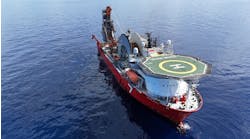Gene Kliewer • Houston
As if to add emphasis to the Douglas-Westwood study of subsea capex spending (see accompanying report), a spate of contracts are in the news.
FMC Technologies has received a $125-million order from Petrobras to supply equipment for use in oil and gas developments offshore Brazil. The order, for 32 subsea trees, represents the remaining equipment under a 107-tree frame agreement that was announced in February of 2010.
Equipment deliveries are scheduled to begin in 2013.
FMC also has signed a five-year global frame agreement withBP to provide subsea production systems and life-of-field services for its worldwide subsea development projects.
In the North Sea,FMC Kongsberg Subsea AS has agreed with ConocoPhillips Scandinavia AS to manufacture and supply subsea equipment and services for a water injection development in the Ekofisk field. The award has a base value of approximately $75 million and is subject to Norwegian Parliament approval of the Plan for Development and Operation (PDO).
FMC’s scope of supply includes eight subsea water injection trees and wellheads, two manifolds, and control systems, with options for an umbilical and additional controls. The equipment will be engineered and manufactured at FMC’s facilities in Kongsberg, Norway, and Dunfermline, Scotland.
Deliveries are scheduled to commence in 1Q 2012.
GE Oil & Gas has received a $7 million contract from Total E&P UK Ltd. to supply drilling and production equipment for the expansion of the Elgin Franklin gas field in the North Sea.
To meet the extreme pressure and temperature demands of the project, GE is supplying surface wellhead and flow control equipment that can operate at well pressures of 15,000 psi (103 MPa) and temperatures of 450° F (232° C).
In addition to the equipment, GE will provide field service installation, training, and maintenance services for the project.
Subsea construction picks up
Saipem is reporting offshore engineering and construction contracts valued at more than $2.2 billion in total.
In Saudi Arabia,Saudi Aramco awarded Saipem an EPIC contract under the framework of the Al Wasit Gas Program. This encompasses the offshore development of the Arabiyah and Hasbah fields, 150 km (93 mi) northeast of Jubail industrial city.
The scope includes engineering, procurement, fabrication, and installation of 12 wellhead platforms, two tie-in platforms, and one injection platform; a 36-in. (91.4-cm) 260-km (161-mi) export trunkline; and around 200 km (124 mi) of MEG pipelines, 200 km of subsea electric and control cables, and 40 km (24.8 mi) of offshore flowlines.
Saipem also will engineer shore approaches and lay around 120 km (74.6 mi) of onshore pipelines. Fabrication activities will be executed mainly by yards in Dammam, where Saipem is in a consortium with Saudi partners. Saipem’s new Karimun yard in Indonesia will handle the larger structures. Offshore activities will be performed mainly by Saipem’s construction vesselsCastoro II and Castoro Otto.
Technip has landed an installation contract, worth more than €20 million ($27.8 million) from EOG Resources United Kingdom Ltd. for the development of the Conwy field, located in the East Irish Sea.
The contract covers:
- Welding and installation of an 11.4 km (0.86 mi), 8-in production pipeline and an 8-in water injection pipeline which is to be trenched and backfilled
- Survey work and pre-commissioning of the pipelines
- Installation of an 11.4 km umbilical, spools installation, and leak testing of the complete production and water injection systems.
Technip’s operating centre in Aberdeen, Scotland, will execute the contract, which is scheduled to be completed in 3Q 2012. The pipelines will be welded at the Technip spoolbase in Evanton, Scotland, and umbilicals will be supplied by Duco, the Group’s wholly-owned subsidiary, under a separate contract. Vessels from the Technip fleet will be used for the offshore installation campaign, including the pipelay vesselApache II and the diving support vessel Orelia.
Technip also got an engineering, procurement, construction, and installation contract worth approximately €45 million ($62.5 million) fromGDF SUEZ, for the Gjøa field development in the Norwegian sector of the North Sea. This contract covers:
- Engineering and fabrication of two smoothbore gas export risers to connect the Gjøa platform with the gas export pipeline
- Removal of the existing roughbore risers and installation of the two new smoothbore risers
- Tie-ins and pre-commissioning activities.
Technip’s operating center in Oslo, Norway, will execute the contract. Fabrication of the risers is scheduled for the Group’s flexible pipe plant in Le Trait, France. Offshore installation, which will be executed with notably theSkandi Arctic vessel from Technip fleet, is scheduled to be completed in the second half of 2011.
DOF Subsea UK has won a £1-million ($1.6 million-) IRM contract for the Baobab field offshore Cote d’Ivoire, operated by Canadian Natural Resources.
The 14-day project is due to start this spring, using theGeoholm vessel. The work scope includes removal and replacement of a multiphase flow meter, and replacement of a choke and a subsea control module, in water depths of around 1,200 m (3,937 ft).
RPSEA calls for deepwater RFPs
The Research Partnership to Secure Energy for America (RPSEA) has released the first of six 2010 Ultra-Deepwater Program requests for proposals to award $22 million for oil and gas research and development projects.
Each RFP will have its own issue and due dates. The following is a list of the various focus areas for the 2010 RFPs:
- 1. Continued work in current projects
- 2. Drilling, completion, and intervention breakthroughs
- 3. Significantly extending subsea tieback distances and surface host elimination
- 4. Dry trees – direct well intervention and risers in 10,000 fwd
- 5. Associated safety and environmental concerns
- 6. Appraisal and development geosciences and reservoir engineering.
For details and qualifications, seehttp://www.rpsea.org/.
Subsea capex spending growth to increase
Douglas-Westwood predicts a 23% growth in subsea hardware capex to $139 billion in 2011-2015 compared to the prior five-year period. In its first “World Subsea Hardware Market Report,” the analysts say the challenge of reaching new reserves is a driver. Others include deeper water developments, more remote locations, and metocean extremes.
Higher oil prices and advancing technology make viable smaller, more widely scattered developments, all of which mitigate in favor of subsea production.
Subsea pipeline spending will account for more than half the capex, says the report. The so-called “Golden Triangle” of West Africa, the Gulf of Mexico, and Brazil will account for more than 60% of all subsea production, SURF, and processing hardware spend over the forecast years.
“This study highlights the astonishing technical capability that exists within the subsea sector and puts into perspective just how capital-intensive oil and gas extraction now is for upstream E&P players,” says Steve Robertson, director.
Offshore Articles Archives
View Oil and Gas Articles on PennEnergy.com


